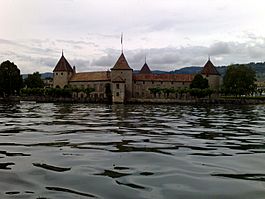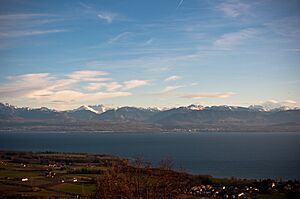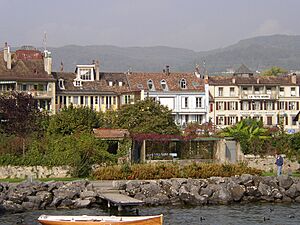Rolle facts for kids
Quick facts for kids
Rolle
|
||
|---|---|---|

Castle of Rolle
|
||
|
||
| Country | Switzerland | |
| Canton | Vaud | |
| District | Nyon | |
| Area | ||
| • Total | 2.74 km2 (1.06 sq mi) | |
| Elevation | 376 m (1,234 ft) | |
| Population
(Dec 2020 )
|
||
| • Total | 6,260 | |
| • Density | 2,285/km2 (5,917/sq mi) | |
| Postal code |
1180
|
|
| Surrounded by | Bursinel, Essertines-sur-Rolle, Gilly, Mont-sur-Rolle, Perroy, Tartegnin, Lake Geneva | |
| Twin towns | Wallisellen (Switzerland) | |
Rolle is a town in the Canton of Vaud, Switzerland. It sits on the northwestern shore of Lake Geneva (also called Lac Léman). The town is located between the cities of Nyon and Lausanne. Rolle is about 30 kilometers (19 mi) northeast of Geneva. It's part of the La Côte wine-growing area and offers amazing views of the high Alps.
Rolle is also famous as the birthplace of Frédéric-César de la Harpe (1754–1838). He was a teacher to Alexander I of Russia. Frédéric-César de la Harpe played a big role in helping the Canton of Vaud become independent from the Bernese.
Contents
History of Rolle
Rolle was first mentioned in old records in 1294 as Rotuli. A year later, in 1295, it was known as Ruello and Ruelloz. In 1330, the town came under the control of Jean De Grailly the 1st, a knight. He was tasked with looking after the future King Edward the 2nd.
Ancient Settlements in Rolle
Long ago, during the late Bronze Age, people lived by the lake in Rolle. Evidence of their settlement was found in 1835. This happened when an artificial island called Île de la Harpe was being built. Another Bronze Age settlement was found in an area called Fleur d'Eau.
Later, between the 1st and 3rd centuries AD, a large Gallo-Roman farm was discovered in La Combe in 1984. In 1985, parts of the moat (a ditch around a castle) and walls of Rolle Castle were found. Bits of a medieval city wall were also found in Champ de verse. These might have been from an older village called Saint-Nicolas de Ver.
Rolle in the Middle Ages
In 1261, some powerful lords, the Lords of Mont, wanted to build a new city by the lake. They hoped it would be a rival to nearby towns like Aubonne and Saint-Prex. Around 1264, Rolle Castle was built. Its purpose was to protect the pier (a landing place for boats) on the lake. However, the Mont family never finished building their planned city.
By 1291, the castle belonged to Count Amadeus V of Savoy. He gave it to different families as a fief, which means they could use the land in exchange for loyalty. In 1295, it went to Knight Jean De Grailly the 1st, who named it Ruello. This name later changed to Rolle.
In 1319, Count Amadeus V of Savoy finally built a city around the castle. This new city filled a gap in the Savoy family's settlements along the northern shores of Lake Geneva. The town was designed with a main street parallel to the lake. A cross street connected the port to the land behind it. This design was common for towns built by the Zähringer family.
People from Saint-Nicolas de Ver, which might have been a failed town, moved to Rolle. The new city was protected by a palisade (a fence of strong wooden stakes). It was given a city charter, similar to the one in Moudon. This charter gave the town certain rights and freedoms. In return, Jean de Mont became a deputy ruler and received some land and businesses.
By 1366, citizens of Rolle no longer had to pay tolls in Aubonne. In 1425, the Duke of Savoy allowed Rolle to hold a weekly market. In 1484, Rolle became a free city, no longer just a feudal property.
During the Bernese invasion in 1536, both Le Rosey Castle and Rolle Castle were attacked and burned.
Rolle Under Bernese Rule
From 1536 to 1798, Rolle was ruled by Bern. It was part of the bailiwick (an area governed by a bailiff) of Morges. In 1558, a Bernese merchant named Hans Steiger bought the barony of Rolle. His family owned it until the French Revolution. This barony included the town of Rolle and several nearby villages.
The local court was made up of the lord, his deputy, a clerk, and ten members from Rolle and the surrounding villages. One of these ten members governed the city. In 1740, the town bought its freedom from some taxes and duties.
Modern Rolle Begins
Rolle was the birthplace of Frédéric-César de La Harpe and Amédée de La Harpe. These two people were very important during the French Revolution and the end of the old system in Switzerland. Towards the end of the 1700s, Rolle was a center for revolutionary ideas.
After France invaded Switzerland in 1798, Rolle became the main town of a new district with the same name. In 1799, the new Swiss government bought the castle from the town. They used it as their government seat until 1974. In 1802, during an uprising called the Bourla-papey, old land titles and tax records were burned in the castle archives.
Geography and Location
Rolle covers an area of about 2.7 square kilometers (1.0 sq mi). A good portion of this land, about 29.6%, is used for farming. Forests cover about 5.5% of the area. Most of the land, about 63.5%, is developed with buildings or roads. A small part, 0.7%, is made up of rivers or lakes.
The town is located right on Lake Geneva, along the main highway between Geneva and Lausanne. Until 2006, Rolle was the main town of its own district. Now, it is part of the Nyon district.
Town Symbol (Coat of Arms)
The blazon (description) of Rolle's municipal coat of arms is Per fess Or and Vert. This means it's divided into two horizontal halves: the top half is gold (Or), and the bottom half is green (Vert).
People of Rolle
Rolle has a population of 6,260 people. About 41.8% of the people living in Rolle are foreign nationals. Over the last ten years (1999–2009), the population grew by about 36.9%. Most of this growth was due to people moving into the town.
Most people in Rolle (about 73.9%) speak French as their first language. Portuguese is the second most common language (4.9%), followed by English (4.3%).
Rolle has a mix of age groups. About 11.4% of the population are children aged 0-9, and 15.8% are teenagers aged 10-19. Adults aged 20-59 make up a large part of the population. There are also many senior citizens, with 8.6% aged 60-69 and 6.1% aged 70-79.
Important Heritage Sites
Several places in Rolle are considered very important to Swiss heritage. These include Rolle Castle, the Library of the Community of Rolle, and Île de la Harpe. The entire old city of Rolle is also recognized as an important heritage site.
Economy and Jobs
Rolle has become a popular place for companies to set up their offices, partly because of Switzerland's tax laws. For example, Yahoo! moved its European headquarters to Rolle in 2008. Ineos, a large chemical company, also moved its main offices here in 2010. Cisco Systems has a significant Research and Development center in Rolle too.
In 2010, the unemployment rate in Rolle was 6.4%. Many people work in different sectors. About 45 people work in farming. Around 388 people work in the manufacturing or construction industries. The largest number of jobs, 2,327, are in the service sector. This includes jobs in sales, transportation, hotels, restaurants, and education.
Many people who work in Rolle travel from other towns. About 6.1% of the workers coming into Rolle are from outside Switzerland.
Religion in Rolle
According to the 2000 census, about 36.6% of the people in Rolle were Roman Catholic. Another 30.9% belonged to the Swiss Reformed Church. There were also people who belonged to other Christian churches, as well as Muslim and Jewish communities. A significant number of residents (14.52%) stated they had no religious affiliation.
Education in Rolle
Many people in Rolle have a good education. About 27.5% of the population have finished high school. Another 15.9% have gone on to higher education, either at a university or a specialized college.
In the 2009/2010 school year, there were 618 students in Rolle's school district. The local school system provides two years of optional pre-school. Primary school lasts for four years, and lower secondary school lasts for six years.
Rolle is also home to the main campus of Institut Le Rosey. This is one of the most famous boarding schools in the world. Many notable people have attended Le Rosey, including members of royal families like Aga Khan IV, King Albert II of Belgium, and Shah Mohammad Reza Pahlavī.
Famous People from Rolle
- Henry Bouquet (1719–1765), a British Army officer who fought in important wars.
- Jean Preudhomme (1732–1795), a Swiss artist known for his portraits.
- Frédéric-César de La Harpe (1754–1838), a Swiss political leader who helped create the Helvetic Republic.
- Amédée Emmanuel François Laharpe (1754–1796), a military leader who fought in the French Revolutionary Wars.
- Ernest Biéler (1863–1948), a talented Swiss painter and artist.
- Flore Revalles (1889–1966), a singer, dancer, and actress.
- Ernst Neufert (1900–1986), a German architect who lived in Rolle.
- Jean-Luc Godard (1930–2022), a famous French-Swiss film director.
- Janine Massard (born 1939), a Swiss writer.
- Andrew Currie (born 1955), a British billionaire businessman who lives in Rolle.
- Anthony Favre (born 1984), a retired Swiss professional footballer.
See also
 In Spanish: Rolle (Vaud) para niños
In Spanish: Rolle (Vaud) para niños












